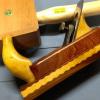I had an opportunity to try out an alternate way of attaching the Festool OF1400 Router to the Festool Guide Rail.
The Festool Smart Router Kit (F-SRK) is a device made by EurekaZone (EZ-Smart) for attaching a router (or other tools) to a Festool Guide Rail. The F-SRK consists of three parts:
Base – the part that slides on the Guide Rail.
Bar – the part that attaches to the Base and allows movement of the router perpendicular to the Guide Rail.
Mounting Plate – the part attached to the Bar that the Router mounts on.
Before using the F-SRK, some adjustments were needed for squareness. The Mounting Plate attaches to the Bar with two bolts and wing nuts. There is a bend in both pieces and the Mounting Plate is intended to be flat on the surface of the work-piece. I disassembled the Mounting Plate from the Bar and bent the angle on both pieces so that both were a right angle. Forming the angle is not an issue, since the parts are aluminum. After remounting the Mounting Plate to the Bar, the Mounting Plate sat flat on the work-piece, as it should - see Photo 1.
The F-SRK Base has plastic parts fitted on the top and bottom of an aluminum plate. Two plastic pieces on the bottom of the Base form a channel over the rib on the Guide Rail. Two plastic pieces on the top of the Base form a channel where the Bar slides. The two sets of plastic channel pieces need to be adjusted.
The sequence I chose was to adjust the Guide Rail channel pieces first. Two recessed bolts lock each of the pieces to the bottom of the Base. The holes are oversized, allowing some adjustment. The purpose of this adjustment is to allow the Base to fit snugly on the Guide Rail, and yet slide smoothly. I had to drill two of the holes in the black plastic parts slightly larger, in order to have ample room for adjustment. I found the adjustment of the F-SRK base on the guide rail difficult to do, since the bolts that allow this adjustment are accessed only from the bottom of the base. It is a trial and error process - removing the base, making the adjustment, trying the base on the rail, and repeating the process.
I have adjusted the F-SRK base on the guide rail many times. The best I can do is to get the F-SRK base to a point where there is a very small amount of play on the rail and it will still slide. If I eliminate the play, the F-SRK will not slide on the rail - it is too tight. I believe it would be easier to make this adjustment if the smaller of the two plastic parts were cut into two pieces, allowing each to be adjusted independently.
Adjusting the top plastic parts on the Base to allow the Bar to slide smoothly and in a line perpendicular to the Guide rail is simple, since the wing nuts that lock the Bar to the Base are accessible from the top of the base. I drew a long line on a work-piece, square to the Guide Rail. Loosening all four wing nuts and adjusting the Bar to slide square to the Guide Rail took only a few seconds - see Photo 2.
With the adjustments completed I moved to mounting the Festool OF1400 Router onto the Mounting Plate. The OF1400 Router has marks on the router base that define the centerline of the router bit. It is important to mount the router to the Mounting Plate so that these marks are accurate. I drew a line on the Mounting Plate, through the center of the hole in the Mounting Plate, and parallel to the Guide Rail. Next I made a secondary base for the OF1400 Router that would fit onto the bottom of the Mounting Plate. This secondary base is necessary to allow countersunk bolts to be used to hold the Router onto the Mounting Plate. The Mounting Plate is not thick enough to drill countersinks directly into the Mounting Plate. I used a round plastic base, offered by Pat Warner, called the “Generic 7 inch Round Plate”. I removed the standard base from the Router, and used it to mark and drill two holes in the Mounting Plate. There are two threaded holes in the bottom of the Router that are not normally used that I chose for the mounting bolts. Bolts were purchased at Ace Hardware. This mounting method has the advantage of simplicity, in that the Router can be removed from the Mounting Plate by removing the two mounting bolts, while the standard router base stays in place on the Router.
The round base was then aligned onto the Mounting Plate and the holes center-punched into the round plastic base. After drilling holes and countersinks, the Router was mounted on the Mounting Plate (Photo 3), and then onto the Bar/Base assembly, and finally onto the Guide Rail (Photo 4).
The assembled unit rides smoothly on the rails. The bottom line is the F-SRK provides an effective alternative for mounting the OF1400 Router on the Festool Guide Rail. Note that any router could be used, just as easily.





 Reply With Quote
Reply With Quote



